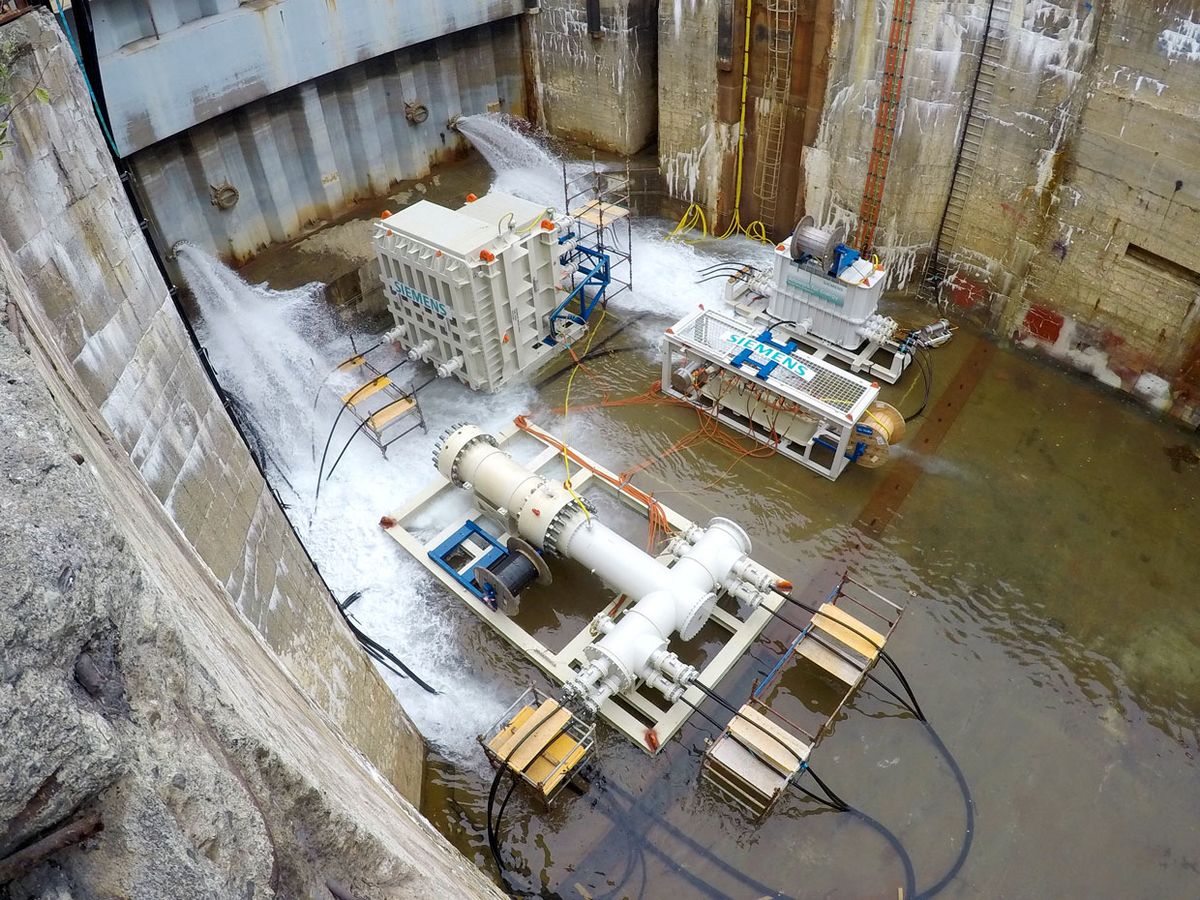Slowly but surely, oil- and gas-drilling technology is migrating from floating platforms to the seafloor. Pumps moved down there decades ago. More recently, compressors (which boost pressure in a well to keep gas flowing) and separators (which isolate oil from water and silt) have relocated to the murky depths.
Putting this equipment closer to wells makes them more productive and energy efficient. Some oil and gas companies even aspire to build subsea factories that extract and process oil and natural gas directly on the seafloor. These factories would be safe from hazards such as icebergs and hurricanes. They would be controlled remotely, reducing labor costs. Eventually, some believe, offshore platforms could be phased out entirely.
However, all of this sunken gear requires electricity. Today, operators typically string power lines from power plants or diesel generators aboard nearby oil rigs to every piece of subsea equipment they install. That works for a few machines, but it’s impractical to string dozens of umbilicals, as they’re known, to the ocean floor.
Industry suppliers ABB and Siemens are now putting the finishing touches on competing versions of the world’s first subsea power-distribution stations. Once installed, these stations would connect via a single line to a “topside” (maritime parlance for above water) generator, wind turbine, or power plant, and redistribute electricity to underwater equipment. “Our technology is an enabling technology for the subsea factory,” says Bjørn Rasch, head of subsea power for Siemens.
Both projects have been in the works for more than five years. ABB will complete its final round of testing in June and expects to install its first subsea power system in 2020. Siemens tested its version in shallow water in Norway last November and is now talking with clients about putting its first unit in the field. “We’re getting close to where we’re actually deploying this technology in a real project,” Rasch says.
Siemens’s model, which the company calls its Subsea Power Grid, consists of a transformer, a medium-voltage switchgear, and a variable-speed drive. Its distribution voltage is around 30 kilovolts, while its variable-speed drive puts out 6.6 kV. The system can provide electricity to devices with power ratings between 1 and 15 megawatts. The umbilical that hooks it to a generation station also includes an embedded fiber-optic cable so operators can run everything from afar.
One of the hardest parts of building the station, Rasch says, was ensuring it could withstand the high water pressure of the seafloor. Instead of encasing all the equipment in a pressurized chamber, engineers flooded the electronics with a synthetic fluid called Midel. This biodegradable fluid inside the equipment maintains the same pressure as the seawater, which alleviates stress. The fluid also passively cools the device by transferring heat from equipment to the chilly seawater.

Chevron, Eni Norge, Equinor, and ExxonMobile have all worked with Siemens to get the company’s project this far. The next step for both ABB and Siemens will be to deliver the first model for installation at an active production site.
Brian Skeels, professor of subsea engineering at the University of Houston and director of emerging technology for the offshore design and consulting firm TechnipFMC, has seen many attempts to “marinize” technologies to work underwater. Dealing with heat is a common stumbling block. If water can’t flow freely around a device, the heat it generates prompts marine life to grow on the equipment, which shortens its life-span. And, Skeels cautions, “what may work in shallow water may not work at deeper depths.”
Both systems are expected to work at depths of up to 3,000 meters and operate for 30 years with minimal maintenance. At the end of their lives, the units can be removed from the seafloor.
A power-distribution center would be just one piece of any future subsea factory—a vision that has captivated the industry for more than a decade. Skeels says the future of subsea processing will depend largely on whether such projects can add more value to the industry than they drain in expense. Investment into subsea processing dried up when oil prices crashed in 2014. Looking ahead, Skeels thinks the technology holds the most potential for remote wells more than 160 kilometers from other facilities.

Hani Elshahawi, digitalization lead for deepwater technologies at Shell, says there are clear benefits to having power readily available on the seafloor. But he doesn’t think subsea factories will supplant all platform activities, or replace any of them in the near future. “It will require decades, in my view,” he says. “We foresee a more gradual and lengthy transition.”
To Rasch at Siemens, though, the industry’s vision of subsea factories does not seem as far out as it once did. “There are many technologies in many companies that are in place or close to being in place,” he says. “This can be realized in the close future, that’s for sure.”
This article appears in the June 2019 print issue as “ABB and Siemens Test Subsea Power Grids.”
This article was updated on 22 May 2019.
